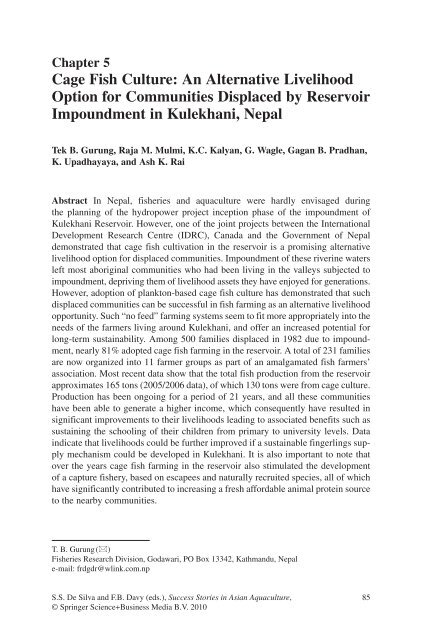Success Stories In Asian Aquaculture - Library - Network of ...
Success Stories In Asian Aquaculture - Library - Network of ...
Success Stories In Asian Aquaculture - Library - Network of ...
- No tags were found...
You also want an ePaper? Increase the reach of your titles
YUMPU automatically turns print PDFs into web optimized ePapers that Google loves.
Chapter 5Cage Fish Culture: An Alternative LivelihoodOption for Communities Displaced by ReservoirImpoundment in Kulekhani, NepalTek B. Gurung , Raja M. Mulmi , K.C. Kalyan , G. Wagle , Gagan B. Pradhan ,K. Upadhayaya , and Ash K. RaiAbstract <strong>In</strong> Nepal, fisheries and aquaculture were hardly envisaged duringthe planning <strong>of</strong> the hydropower project inception phase <strong>of</strong> the impoundment <strong>of</strong>Kulekhani Reservoir. However, one <strong>of</strong> the joint projects between the <strong>In</strong>ternationalDevelopment Research Centre (IDRC), Canada and the Government <strong>of</strong> Nepaldemonstrated that cage fish cultivation in the reservoir is a promising alternativelivelihood option for displaced communities. Impoundment <strong>of</strong> these riverine watersleft most aboriginal communities who had been living in the valleys subjected toimpoundment, depriving them <strong>of</strong> livelihood assets they have enjoyed for generations.However, adoption <strong>of</strong> plankton-based cage fish culture has demonstrated that suchdisplaced communities can be successful in fish farming as an alternative livelihoodopportunity. Such “no feed” farming systems seem to fit more appropriately into theneeds <strong>of</strong> the farmers living around Kulekhani, and <strong>of</strong>fer an increased potential forlong-term sustainability. Among 500 families displaced in 1982 due to impoundment,nearly 81% adopted cage fish farming in the reservoir. A total <strong>of</strong> 231 familiesare now organized into 11 farmer groups as part <strong>of</strong> an amalgamated fish farmers’association. Most recent data show that the total fish production from the reservoirapproximates 165 tons (2005/2006 data), <strong>of</strong> which 130 tons were from cage culture.Production has been ongoing for a period <strong>of</strong> 21 years, and all these communitieshave been able to generate a higher income, which consequently have resulted insignificant improvements to their livelihoods leading to associated benefits such assustaining the schooling <strong>of</strong> their children from primary to university levels. Dataindicate that livelihoods could be further improved if a sustainable fingerlings supplymechanism could be developed in Kulekhani. It is also important to note thatover the years cage fish farming in the reservoir also stimulated the development<strong>of</strong> a capture fishery, based on escapees and naturally recruited species, all <strong>of</strong> whichhave significantly contributed to increasing a fresh affordable animal protein sourceto the nearby communities.T. B. Gurung ()Fisheries Research Division , Godawari , PO Box 13342 , Kathmandu , Nepale-mail: frdgdr@wlink.com.npS.S. De Silva and F.B. Davy (eds.), <strong>Success</strong> <strong>Stories</strong> in <strong>Asian</strong> <strong>Aquaculture</strong>,© Springer Science+Business Media B.V. 201085
















